We’ve been telling stories for a long time. Thanks largely to technological progress we’ve got a host of new media to play around with than we did thousands of years ago, but we’ve also hit more than a few dead ends, worn out genres or explored them seemingly to exhaustion. But the most innovative storytellers are capable of revitalizing modes of narrative, escaping from entrenched clichés and tropes that have been driven into the ground, taking things to the next plateau and forcing future creators not to settle for mediocrity. If you’re an aspiring creator, as I think many of us are, investigating some of the recent successes in this direction can help show us how the best of this generation are continually pushing things forward.
One of the most effective ways of doing this is by narrativizing genre or medium conventions, taking accepted tropes that have become so entrenched that they’re virtually transparent and using them as significant story elements rather than shortcuts or concessions to the limitations of the form. Not just calling attention to the trope as a comment on the contrivances of narrative (such as breaking the fourth wall). Not just deconstructing it in order to investigate its previously ignored implications (as in Alan Moore’s take on superheroes in The Watchmen). But acknowledging it head-on and making into a full-fledged component of the story, or even the driving force behind the story itself.
The first example of this that comes to mind is in the second season finale of House, an episode titled “No Reason.” Dr. House begins to suspect that he’s not in his right mind following an incident where he’s shot by a man claiming to be a former patient. After waking up, House finds that he’s suffering from hallucinations and memory lapses; he learns that he’d been treated with ketamine while unconscious and hypothesizes that this might have something to do with his failing mental faculties.
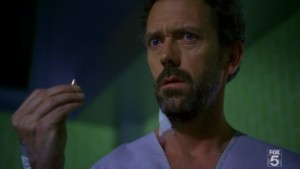
So far pretty standard for House, and for psychological/medical mysteries on television in general. Also standard, so much so that we don’t even notice it anymore, are the scene transitions that occur throughout the episode. Over its history, film and television have developed a sophisticated vocabulary for signalling what’s going on without needing to explicitly telegraph it. For instance, there’s the establishing shot: if we’re shown the exterior of an apartment building, and then a group of characters sitting around a kitchen table, we instantly understand that those characters are inside that building without it having to be made obvious through, say, dialogue. House deconstructs the establishing shot throughout the series with its zooming-in close-ups of the internal organs of patients, usually with an accompanying voiceover of House describing the particular anatomical defect or process that’s gone awry. This was a new convention that became necessary because of the audience’s prior lack of familiarity with the often obscure medical conditions referred to in the show, and became possible because of new filmmaking technology that allowed the show to visualize with relative accuracy what was being described. However, this new convention wasn’t ever narratively significant in the show; it was just a cool-looking effect that helped the audience understand what was going on without requiring a medical degree.
In “No Reason,” something related, yet much more significant happens. House begins to notice the scene transitions. We, the audience, are so accustomed to the cinematic shorthand of one scene cutting to another (to indicate that the characters have gone somewhere else and it’s now a later time) that we don’t even think about it anymore. When House and his team are in the Intensive Care Unit one moment, and then walking down a staircase the next, we don’t say “How the hell did they get there so fast?” We understand that they must have got up, walked down the hall or whatever, and now, at some later point that we can derive from context cues, they’re in the stairwell.
And yet “how did we get here?” is precisely the question that House himself asks after that scene transition. He doesn’t remember how he got from Intensive Care to the stairwell – and neither do we. In our privileged position as audience, we had, up to that point, an advantage over the characters in the show, in that we got to skip over the boring parts (walking from one room to another) wherein nothing plot-relevant happens, whereas the characters (we presume) had to live through them. But by recontextualizing the cut between scenes as a diegetic event of which House is aware, “No Reason” turns what had been a purely technical effect for the sake of audience convenience and turns it into a plot device, makes it into part of the story in a way that simultaneously forces us to rethink our assumptions about how we watch television while also making perfect sense as a story element.
Obviously House didn’t go on using this throughout the series, because having every scene transition be a time-jump for a hallucinating and/or comatose Greg House is not really the point of the show (although try going back and watching the whole series again while pretending this is the case and see what happens…now that I think about it, Buffy did an episode like this too, which maybe fits the same mold). But at least for this one episode, repurposing a filmmaking technique so that it actually serves the story was a powerfully effective narrative maneuver.
The Cabin in the Woods is a movie that narrativizes genre conventions in a way that potentially revolutionizes the whole genre itself. In fact, Cabin in the Woods takes as its whole premise the recontextualization of the horror genre by distilling it to a few of its core tropes and making the movie about those tropes. Yet it’s not a parody or a purely meta horror film like Scream. There’s a very real sense in which Cabin in the Woods contains every other horror movie ever made, and does things that may have pushed the genre into the next stage of its evolution by doing so.
Spoiler warning begins here. Though this movie has so many twists that basically every piece of information about it can’t help but be a spoiler.
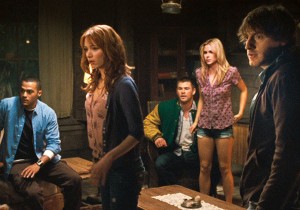
Total archetypes, amirite?
Ultimately the movie’s premise is that there’s an international organization that has, for millennia, been contriving an annual ritualistic bloodbath. They orchestrate a situation wherein five young people corresponding to certain archetypes are isolated and forced to contend against one or more persons or monsters that go around and brutally slaughter them all (or all-but-one) for no apparent reason. I.e. the plot of all horror movies ever. We follow one such group of college kids as they travel to the titular cabin in the woods, unknowingly to their inevitable doom. While at first we’re not sure of the motivations of the guys making sure that these kids get killed – is it a psychological experiment? A reality show? – by the end we learn that in fact it’s an ancient blood ritual to ensure that ancient evil gods stay dormant beneath the earth by giving them regular sacrifices.
Unlike a deconstruction – which is closer to what Scream did – where tropes would be “played straight,” or investigated as they might turn out in real life to expose how unrealistic horror movies are, Cabin in the Woods justifies the tropes instead. It asks why would these repeated patterns exist from a diegetic point of view, and produces answers on its own terms:
Why do horror movies always include a group of young people, usually five, who fall into such predictable and even stereotypical roles? Because the ritual requires the blood of very specific people in order to work correctly. Why do characters in horror movies make such fatally stupid decisions when faced with these life-and-death situations? Because they’re being manipulated with chemicals and drugs and psychotropic gas to ensure that their deaths occur in just the right way. Why do bad things happen to good people? To prevent even worse things from happening to everybody.
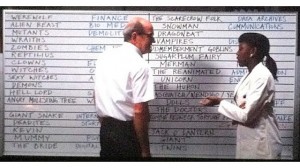
“Sexy Witches” or “Angry, Molesting Tree”? Decisions, decisions.
Boom. All of a sudden clichés that have been tired for decades are refreshed. The filmmakers pull back the focus, but reveal more than just the schematic for the paint-by-numbers approach to the genre (or pain-by-numbers might be more appropriate), presenting the numbers with all the paint stripped off. And it does even more than show us the “frame” in which these movies hang (in the way that Wes Craven’s New Nightmare sort of did, a reboot of the original Nightmare on Elm Street movie that was about a Freddie Krueger haunting the production of a reboot of the first Nightmare on Elm Street movie). It gives us the philosophical underpinnings of what horror movies do, but it does so as a horror movie instead of, for instance, a film school textbook. Good filmmakers will from now on need to take this into account; the meta-awareness that their movie might just be a subset of Cabin in the Woods. Will they work within that knowledge? Will they try to avoid all those tried-and-true horror tropes as a way to prevent their movie from being nothing but a limb of Cabin in the Woods? Will they ignore it entirely? No matter what happens, from now on Cabin in the Woods and its cosmology is a part of the paratext surrounding every horror movie, compelling innovation for the future.
Your move, rest of the genre.
Videogames, too, have their genre conventions. These often serve as limitations on gameplay, and although that’s definitely not always a negative thing (delineated borders are, after all, what makes a genre or medium distinct from others, and enable variation and experimentation), they’re rarely justified narratively. The finite number of “lives” you get in, say, the Super Mario Bros series (and most other early similar games), is never really explained. There’s no narrative justification for Mario’s ability to return from the grave a few times before the player is required to restart, or why a certain type of mushroom increases the limit on his resurrections. As the medium matured, “lives” went out of fashion and in many game genres we ended up with an infinite number of retries with more or less no consequences.
While these conventions never really detracted from the enjoyment of games’ storylines, some of the most ingenious games narrativized the trope in ways that significantly added to the depth of the game’s mythology or cosmology, making them more immersive, more thoughtful, and more fun. A few of the most notable examples:
The cult classic RPG Planescape: Torment solves the resurrection problem by having its protagonist start off dead. The whole plot of the game focuses on existential questions of the value of life and the meaning of death, and a central mystery that the main character sets out to solve is, why do I keep coming back when I die?
Prince of Persia: The Sands of Time, a reboot of the classic Prince of Persia series from the late 1980s and early 1990s, introduces the Dagger of Time, a weapon powered by the titular sands of time, the use of which resource allows the protagonist to rewind events by up to ten seconds. This provided the player a way to undo mistakes and try again, with the added convenience of not needing to start back at the beginning of the level or some arbitrary save point, while including even the rewound events in the “canon” of the unfolding story.
A different way of avoiding the multiple-lives issue is permadeath. That’s pretty much what it sounds like: death is a one-time, permanent event. If your character dies, all your progress in the game goes with it and you have to start again from the beginning. Permadeath is a predominant convention of the Roguelike genre of games, which, following in the footsteps of its archetype, the ASCII-art adventure game, Rogue. Rogue’s other contribution was procedurally-generated content – specifically, the dungeons through which the player moves is not set down ahead of time but is created via an algorithm that changes with every game, so that no two runs can ever be the same.
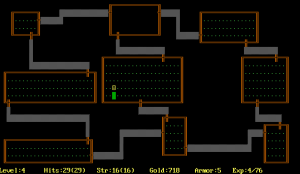
Rogue
Narrativizing these genre conventions could be trivial – the character goes through a certain dungeon and then dies, and the next game is a totally different character in a totally different dungeon which doesn’t need to resemble the first. But a recent game, the very aptly named Rogue Legacy, takes the genre to a new level (videogame pun, sorry) with its narrativization that, much like Cabin in the Woods, expands the storytelling space by justifying its tropes diegetically. And, also like Cabin in the Woods, looking at how and why it works is instructive for anyone who wants to create innovation in art.
Rogue Legacy includes both permadeath and character progression. If, while proceeding through the (procedurally generated) castle, your character dies – that’s it, he or she is dead forever. However, you can restart the game as the previous character’s child. The next game begins decades later in game-time, where you choose one of the dead adventurer’s heirs to control and try to conquer the castle again – to carry on their ancestor’s legacy. Any gold, armour, and upgrades collected by the previous generation is passed on to the next as an inheritance, allowing the player to make progress over hundreds or even thousands of diegetic years. The procedurally generated levels is also included and accounted for narratively: within the castle you find letters written by an ancestor that explains the castle itself moves around and changes, reforming like Gormenghast or Hogwarts (can I just point out here that my spellchecker doesn’t know the word “Gormenghast” but does know “Hogwarts”? That’s a little bit…something).
So both of the defining tropes of the roguelike genre, permadeath and procedurally-generated levels, are incorporated into the narrative of Rogue Legacy, which greatly contributes to the effectiveness of its storytelling and the immersiveness and enjoyment of the gameplay.
There are a million and one ways to tell stories, of course. It’s doubtful that we’ll ever run out of them. But finding new methods to breathe life into tired or hackneyed genres, by narrativizing tropes or otherwise, can make relevant again what once was innovative but over the years and centuries decayed into cliché. As we all do. Restart!
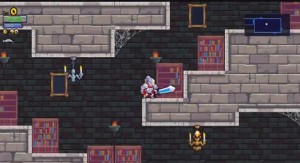
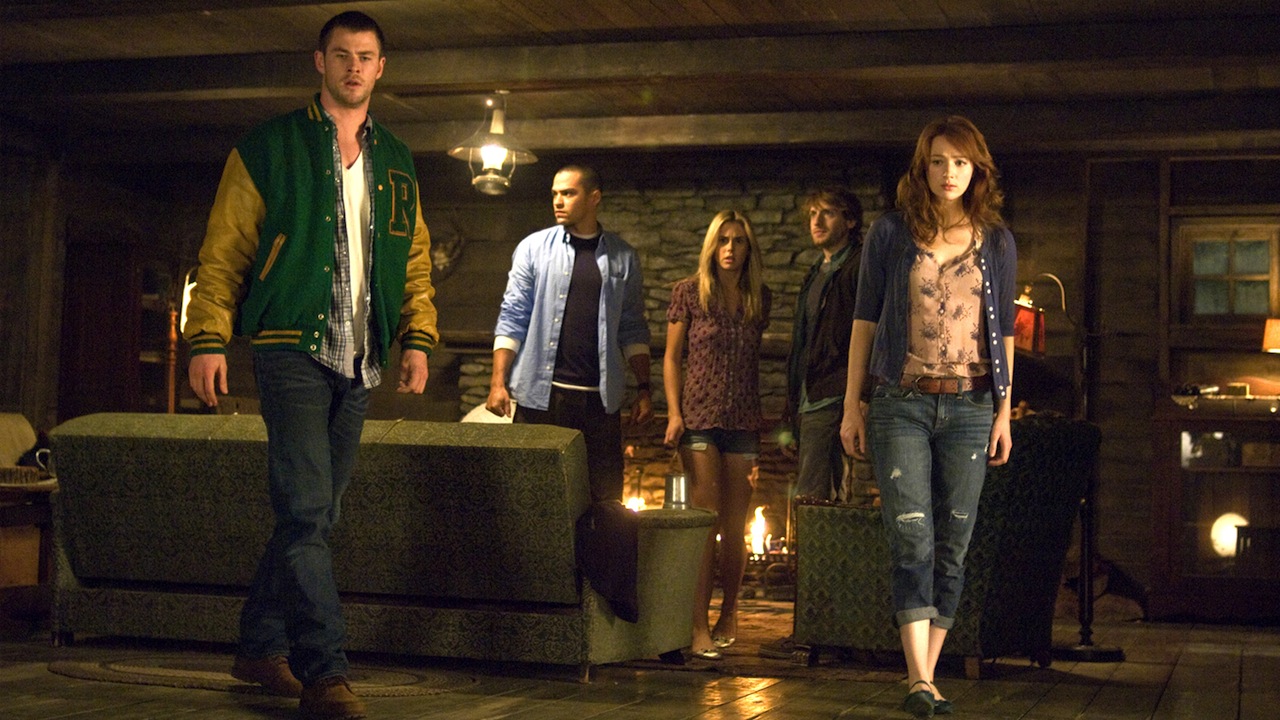
Hi Richard,
Thank you for this interesting article. One thing that came to my mind when discussing characters noticing scene transitions is the Cafe scene in Inception: it starts out with the characters sitting in the Cafe and the audience does not question how they got here – but when Cobb asks Ariadne about it, she goes blank. He points out how the scenery in dreams can suddenly change without the dreamer noticing it. At the same time, this more or less breaks the fourth wall, since he is obviously talking about the same scene transition that the audience has just witnessed.
As for video games, I must admit that I have never played Bioshock beyond the free demo part, but I understand there is a lot going on regarding the way that video games will give the player only very limited choices (which is necessary from a technical standpoint) and what might be the in-story reason for this. I don’t want to go further into this for reasons of a) spoilers and b) my knowledge about it being only second-hand.
I remember the first Command & Conquer game (yes, that’s how old I am) as the first instance of a game that integrated its installation into the narrative: the installment process would be presented as the creation of a satellite uplink to your command center. From then on, the game would alternate between video “communications” with your superiors and actual real-time game scenarios, thus creating the illusion of a continuous real-life process as opposed to a video game broken up into discrete chapters. However, losing a match was not integrated into the narrative in the way you mentioned above.
Now I feel like re-watching Inception and Cabin in the Woods. Which is not unusual, it’s pretty much how I feel every day. But I also really feel like playing Command & Conquer with House running on the TV. Weird.
When I read the subtitle on the main page I assumed you were going to talk about the Japanese horror film “House” or “Hausu” which is one of the genre bending-est film of all time. I just wanted to mention that before I actually read the piece.
Actually, it should have been House the movie series, in particular House 2, which took potshots at the haunted house series and featured John Ratzenberger as Bill the Electrician.
Well, actually, it should have been ‘Big Momma’s House’, which narrativizes the trope of large-black-woman-as-protector, attempting to justify why an actor would “put on the fat suit” to take up such a role, instead of a straight parody like the ‘Madea’ films. This obviously leads to a re-thinking of performances such as Hattie McDaniel’s classic ‘Mammy’ in ‘Gone with the Wind’.
I understand the “purpose” of deconstructing tropes to call attention to the problematic aspects of them–often they are lazy, illogical, sexist, racist, or a fun combination of the above.
But what is the “purpose” of creating an explanation for a trope? Is is to parody the genre? To call attention to the contrivances of storytelling? Or are these movies and games trying to have their cake and eat it too- to put themselves above cliches while indulging in them?
My guess would be the latter two. From a deconstructionist standpoint, you could say that creating an explanation for a trope also draws attention to it, and if the trope is problematic for the reasons listed above – sexist, racist, etc., it could, theoretically, encourage people not to use those tropes. In theory, an audience member, after watching Cabin in the Woods, might be more aware of the archetypes used in horror movies, and might walk out of future archetypical horror movies saying, “this is less interesting/less fun now that I see how predictable/racist/sexist/lazy these tropes are.” And letting the audience come to that conclusion on their own is almost always more effective than, say, picketing with signs in front of whatever property you find sexist/racist/offensive.
As for having your cake and eating it, too, I don’t think that’s the case with Cabin in the Woods, per se, because it feels very intentionally crafted, although I’m not familiar with that episode of House or the video games mentioned in this article. That is, however, a pretty common trope known as “lampshade hanging.” You can read all about it here: http://tvtropes.org/pmwiki/pmwiki.php/Main/LampshadeHanging
I believe we’ve all become more informed about media in this day and age. My flatmate used to argue that things didn’t have to mean something, he could just appreciate Battleship as a fight between the military and aliens, that there wasn’t a need to look any further.
I of course, have educated him about this. Now he’s able to discuss tone, theme and subtext. Even at a shallow level. We have so much media around us that it’s not difficult to see the trends and habits.
Using them as a mechanic, as suggested in this article, is a savvy way of having your cake and eating it. You are pointing out the cliches and appearing above them by lampshading them. When this is successful, it’s a great mechanic to see unfold. The main idea seems to be that as long as your media is saying something, even if it’s, “look at this weird trope” then that’s fine. If it’s just for the hell of it (*cough* Community Season Four *cough*) then it comes across as pointless and hollow.
I’m planning a pen and paper RPG soon, where the players are playing a television show using the Primetime Adventures system, but they’re also playing the makers of the television show using the World of Darkness system. So they’re playing characters playing characters. I already planned on using genre conventions and our relationship with fiction as focal points of drama. This article will make it that much more messed up and hopefully awesome for it.
How did neither Bioshock get a mention (By neither I mean Bioshock nor Bioshock Infinite). Both of the games were about subverting video game conventions in a way that really encapsulates (most) genres.
*Here there be spoilers*
In the first game, the big plot twist that occurs tragically early is the discovery that your character (and by extension, you) is actually subject to mind control. You’ve been conditioned to obey every instruction the quest giver provides whenever he prefaces it with “Would you kindly…” The moment really forces the player to stop and think about why you decided to just blindly trust this voice. What made you trust him? Why didn’t you ever question his motives, or make your own decisions?
The answer is twofold. Firstly, because it’s how you’ve been conditioned (much like the in-game protagonist) to follow directives in video games. That’s just how you play them. Secondly, and the reason this plot twist’s early occurrence is tragic, is that the game doesn’t let you do much else. The game has some choices, but it’s pretty linear. So unfortunately, once the game has you questioning your autonomy, you’re not given any ability to change based on this new behavior as a gamer. In-game, the character breaks free and turns on his former master. As a gamer, you’re merely forced to take order from a different voice actor. The true master, the rails of the game, stay the same.
But Bioshock Infinite takes that very premise on directly. Throughout the narrative, it calls into question the impact of choice. You’re given a few minor choices through the game (the bird or the cage), but none have any real impact on the story. And a few characters wax philosophic about “variables and constants,” and how no matter what you do, some things are fixed and you keep ending up in the same place. And in the perfectly timed plot twist in this game, you end up being forced to take actions despite your will. In fact, it throws your own will in your face.
In a pivotal moment, you’re forced to give ‘your’ daughter away. The game even requires you to take the action, instead of taking over character action and turning it into a cutscene. Instead, it keeps you in a room, and waits for you to accept your fate. If you resist and refuse to take action, the game even prods you. “Booker, you don’t leave this room until you do.” You can delay action, or stop here and be stuck for ever in this point, but the only way forward is by taking the action the game, and the world your character inhabits, requires for you to move forward.
All games require this to some degree or another. Most do so constantly. It’s today’s digital world it’s a basic programmatic paradigm: y function or state is triggered by x action. Until you beat collect 20 stars, you can’t unlock this room. Util that ball gets past a paddle, no points will be awarded and the game cannot be won. The extent to which it’s obvious is story based games depends largely on how good the level design is, but all games have walls, limits, and roadblocks. It’s not only the core of every video ever created, it’s central to our modern digitally integrated society.
Bioshock Infinite takes this convention and not only embraces it, but telegraphs it loudly and clearly in the most pivotal moments. And in doing so, made pressing my ‘F’ key to proceed absolutely gut-wrenching.